Are you planning to create an online learning portal?
Even though digital learning solutions have been around for a good while now, it wasn’t until recently that the true potential of online learning was fully realized.
Thus, making online learning platforms like Udemy, Coursera, & edX super popular among the users.
Fast-forward to 2024, education-focused businesses and start-ups are considering to build their own e-learning platform. This won’t only help them deliver better online learning services to their end user, but also reach billions of potential audience base.
And if you are one of them, this e-learning portal development guide is for you.
Here, we shall be going through everything from a basic introduction to the concept of online learning portals to all the way to steps to development, cost, and monetization.
Therefore, with this being said, let’s get right into it:
Understanding Online Learning Portals
Let’s the most basic question first.
What is an online learning portal?
At its core, an online learning portal is a digital platform designed to facilitate educational experiences over the Internet.
These platforms serve as comprehensive environments where learners can access courses, materials, and interactive tools to enhance their knowledge and skills in various domains.
The development of an online learning portal involves creating a virtual space that supports a wide range of educational activities.
From video lectures and quizzes to forums and peer-to-peer interactions.
It’s not just about hosting courses; it’s about building an integrated environment where users can learn, interact, and grow.
Whether the goal is to create an e-learning platform for professional development, academic instruction, or personal enrichment, each aspect of the portal, from user interface design to content curation, plays a crucial role in its success.
As the demand for accessible and flexible education continues to grow, the opportunity to build your own e-learning platform or create your own online course platform has never been more appealing.
Types of Online Learning Portal
Falling in web development realm, online learning portals come in shapes and sizes.
Understanding these different types can help in tailoring your platform to meet the diverse requirements of learners and educators.
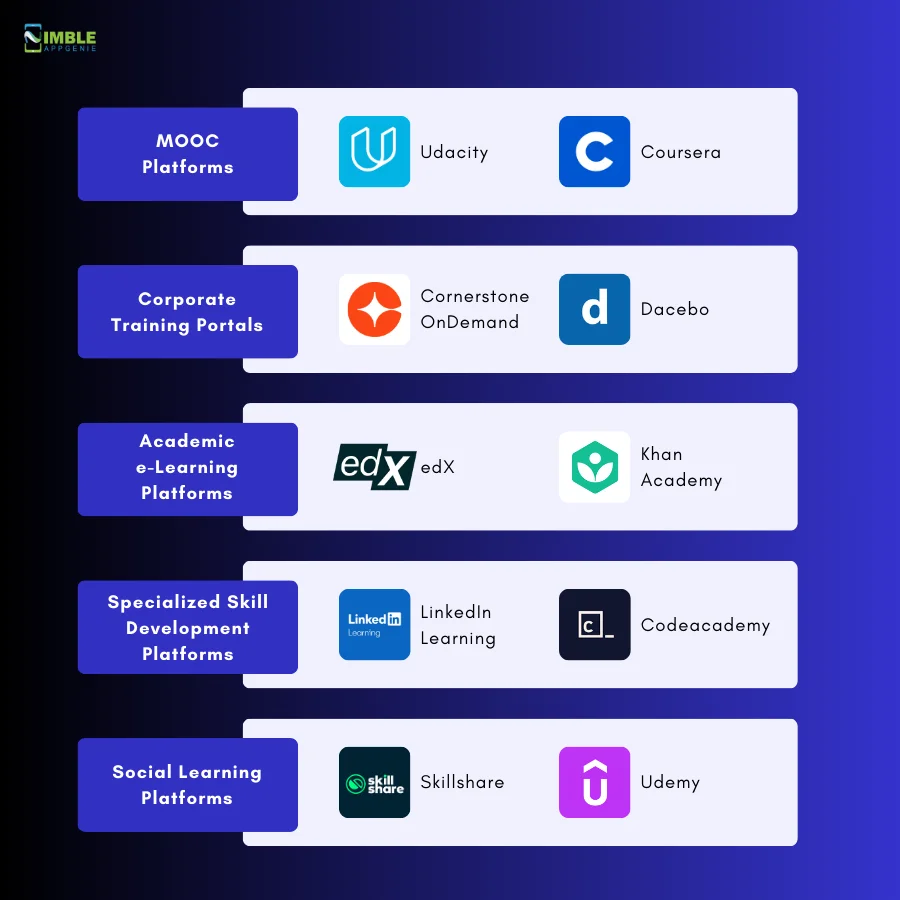
Here are some of the primary forms of online learning portals:
Type 1: MOOC Platforms (Massive Open Online Courses)
A lot of people who consider this project, want to develop an app like Udemy or Coursera.
So, which type do they fall in? The answer is: Massive Open Online Courses
MOOC platforms, like Udacity and Coursera, are perhaps the most well-known type of online learning portals.
They offer a wide range of courses on numerous subjects, allowing anyone with an internet connection to learn new skills or enhance existing ones.
These platforms typically feature courses designed by industry experts and academicians, making high-quality education accessible to a massive audience.
Type 2: Corporate Training Portals
Example: Cornerstone OnDemand and Docebo
As the name suggests, this type of online learning platform are designed to address the specific learning and development needs of businesses, corporate training portals are tailored for professional skill enhancement.
These platforms are often customized to the organization’s requirements.
Therefore, facilitating the training of employees in areas such as compliance, software skills, and leadership.
Corporate training portals are essential for companies looking to invest in their employees’ continuous professional growth. And that’s one of the big reasons why so many none-edTech businesses want to create online education platform.
Type 3: Academic e-Learning Platforms
Example: edX and Khan Academy
These portals are specifically designed for schools, colleges, and universities, providing a digital extension of the traditional classroom.
They support a range of functionalities, from hosting lecture videos and course materials to facilitating assignments and examinations.
Academic e-learning platforms are integral to modern education, enabling institutions to offer blended learning experiences.
Type 4: Specialized Skill Development Platforms
Example: LinkedIn Learning and Codecademy
Want to create an eLearning website to that focuses on a specific subject?
That’s exactly specialized skill development platform.
Focusing on niche areas of learning, these platforms cater to specific interests or industries, such as coding, digital marketing, or graphic design.
They provide specialized courses that allow learners to dive deep into subjects and acquire skills relevant to their career aspirations or personal interests.
Type 5: Social Learning Platforms
Example: Skillshare and Udemy
Lastly, we have one of the most popular type of online learning portal, social leaning platforms.
Emphasizing the communal aspect of learning, social learning platforms integrate social media elements to enhance user engagement and knowledge sharing.
These portals encourage peer-to-peer learning, discussions, and collaboration.
By recognizing the diverse needs of learners, you can start your own online course or create an online education platform that resonates with your target audience.
Each type of online learning portal offers unique opportunities to make online course websites.
So, these are the various types, you can choose from when you create your own e-learning platform. With this out of the way, let’s dive into the market.
Statistics: Growing Market for Online Learning Portal
Every wondered what’s all the noise about?
Well, the market for online learning or what we call eLearning is growing at an amazing rate. That’s one of the big reasons to invest in creating your own learning platform.
Here are some top statistics showing just that:
- The global eLearning market is expected to reach $336.98 billion by 2026 . That’s a significant chunk of change, and it’s projected to keep growing at a Compound Annual Growth Rate (CAGR) of 9.1% from 2018 to 2026 .
- The number of people turning to online learning is skyrocketing. Platforms like Coursera have seen a 438% increase in registered learners in just the last five years, reaching a staggering 136 million users .
- Businesses are recognizing the value of online learning. A whopping 90% of organizations now offer some form of digital learning to their employees, with 68% of employees preferring to learn at work .
- The growth isn’t limited to any one region. The Asia Pacific market is experiencing a particularly strong 20% annual growth in revenue , with other regions like India and China showing impressive growth rates as well.
Popular Online Learning Portals
Market is filled with amazing online learning apps and portals.
If you want to be the next big name of the list, you need to learn from the best. So, here are some of the top online learning platforms along with their success drivers.
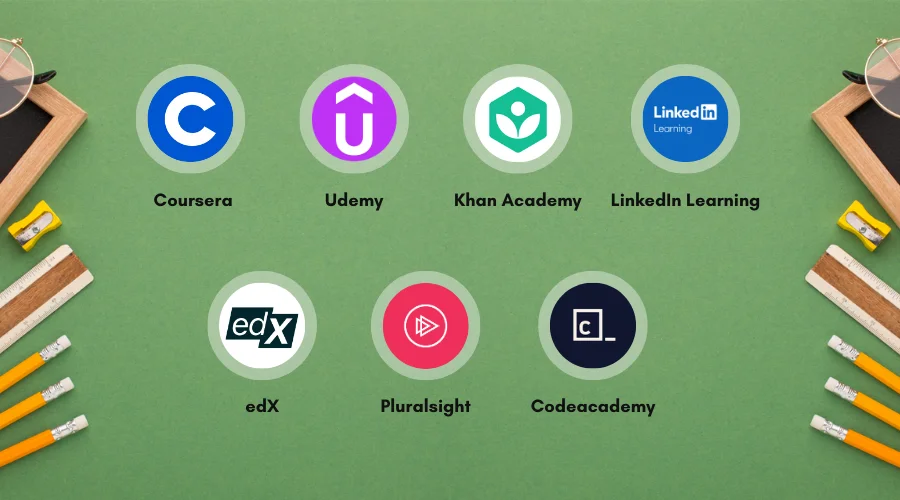
Let’s get right into it:
1. Coursera
Coursera partners with top universities and organizations worldwide to offer courses on a variety of subjects.
The main selling point is its commitment to academic rigor and collaboration with prestigious institutions, ensuring high-quality content.
The platform’s success is also due to its flexible learning schedules and provision of recognized certification upon course completion.
What Makes Coursera a Success:
- Collaboration with top-tier universities
- Wide range of course offerings across various fields
- Flexible learning schedules to accommodate learners
- Certification that adds value to the learner’s professional profile
2. Udemy
Udemy stands out for its vast selection of courses, covering everything from technology to personal development.
The key to Udemy’s success is its open marketplace model, which allows anyone to create and sell a course.
This democratization of content creation has led to a diverse and extensive catalog of learning materials.
What Makes Udemy a Success:
- Open marketplace model allowing for a diverse range of courses
- Ability for anyone to create and sell courses
- Broad spectrum of topics from technology to personal development
- Frequent discounts and promotions making courses accessible to a wide audience
Also Read: How To Create An App Like Udemy?
3. Khan Academy
Khan Academy is renowned for its free, world-class education for anyone, anywhere.
The platform’s strength lies in its personalized learning dashboard, which allows students to study at their own pace in and outside of the classroom.
Its focus on mastery learning and the extensive use of video content are significant contributors to its effectiveness.
What Makes Khan Academy a Success:
- Completely free, making high-quality education accessible to all
- Personalized learning experiences with a focus on mastery learning
- Extensive use of engaging video content
- Wide range of subjects from K-12 through to early college
4. LinkedIn Learning
Formerly known as Lynda.com, LinkedIn Learning offers a wide range of courses aimed at professional development.
Its integration with LinkedIn’s professional networking platform allows for personalized course recommendations based on job role and skills, making it a powerful tool for career advancement.
What Makes LinkedIn Learning a Success:
- Integration with LinkedIn’s professional network for personalized learning
- Focus on professional development and career skills
- High-quality content produced by industry experts
- Learning paths to guide users through comprehensive skill development
5. edX
edX is another leading platform that offers university-level courses in a wide range of disciplines.
A key takeaway from edX is its collaborations with Ivy League universities and its commitment to providing access to high-quality education.
The platform also offers MicroMasters programs and professional certificates.
Thus, adding valuable credentials for learners.
What Makes edX a Success:
- Partnerships with prestigious universities, including Ivy League institutions
- Offering of MicroMasters programs and professional certificates
- High-quality, university-level courses in a wide range of disciplines
- Commitment to accessible and affordable education
6. Pluralsight
Pluralsight focuses on tech-oriented courses, particularly in software development, IT, and creative skills like 3D animation and motion graphics.
Its success lies in its skill assessments and learning paths, which guide learners through a series of courses to acquire in-demand tech skills efficiently.
All in all, it has inspired many to build an online course website of their own.
What Makes Pluralsight a Success:
- Specialization in technology and creative skill development
- Skill assessments to personalize learning paths
- High-quality content tailored to industry needs and trends
- Focus on practical, hands-on learning experiences
7. Codecademy
Lastly, we have Codecademy
It is dedicated to teaching coding skills in an interactive, engaging way.
What sets Codecademy apart is its hands-on learning approach, where users write real code and receive instant feedback.
This practice-oriented method has proven effective in building practical coding skills.
What Makes Codecademy a Success:
- Interactive, hands-on coding exercises
- Immediate feedback system to reinforce learning
- Free access to core content, making coding education accessible
- Courses designed to cater to both beginners and more advanced learners
So, these are the top inspiration to start your own online course selling platform. And it’s time to answer the next big question.
3 Reasons Why Businesses (& Startups) Should Develop Online Learning Portals
It goes without saying, building your own eLearning website can be big decision in many ways.
And this begs the question “Why Develop An Online Learning Portal?”
Developing an online learning portal presents a multitude of benefits for businesses and startups, particularly in today’s digital and fast-paced world.
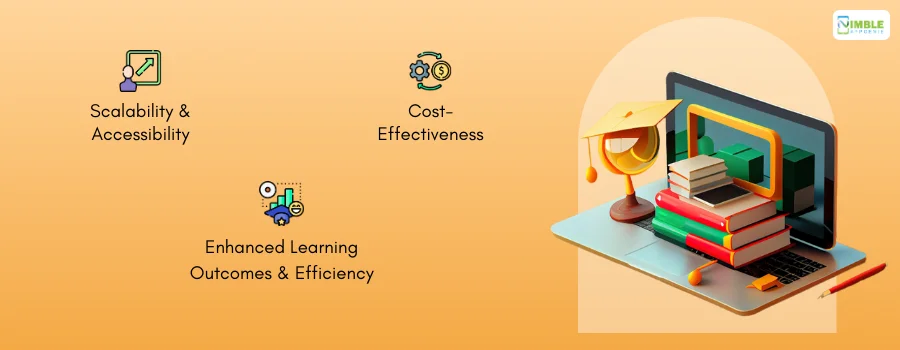
Take a look at the below:
► Scalability and Accessibility
In the era of globalization, businesses are increasingly spread across different regions, making traditional in-person training challenging and costly.
Online learning portals offer a scalable solution.
This allows companies to train hundreds or even thousands of employees across the globe simultaneously.
A report by Research and Markets forecasts that the Global E-learning Market is set to reach $325 billion by 2025, up from $107 billion in 2015, indicating a significant shift towards digital learning solutions.
This scalability ensures that as your business grows, your training and development efforts can grow with it, without incurring proportional increases in cost.
Studies suggest that e-learning requires 40-60% less time to learn than in a traditional classroom setting due to the ability to train at one’s own pace and convenience.
► Enhanced Learning Outcomes and Efficiency
E-learning platforms can lead to better learning outcomes due to the flexibility and personalization they offer.
According to the Research Institute of America, eLearning increases retention rates 25% to 60% whereas retention rates of face-to-face training are very low in comparison at 8% to 10%.
This is because learners can engage with the material at their own pace and revisit content as needed, leading to a deeper understanding.
For startups and businesses, this translates to more effective training, ultimately enhancing employee performance and productivity.
► Cost-Effectiveness
Create an online learning portal can significantly reduce the costs associated with traditional training methods.
This includes venue hire, travel, and printed materials.
The eLearning Industry found that companies can achieve an 18% boost in employee engagement from eLearning, leading to increased productivity without the substantial costs of traditional training methods.
In addition to this, once a course is developed, it can be delivered multiple times to many employees, offering economies of scale that traditional training cannot match.
Online Learning Portal’s Essential Features
Now, before we move any further in this blog, let’s look at some features.
Regardless of the type you are developing, features do play an important role in success of the platform as whole.
We have seen countless apps failed due to lack of right features.
To avoid that, let’s look at some basic feature that you should consider including when you want to create an online course platform.
| Feature | User Panel | Tutor Panel | Parent Panel | Admin Panel |
| Account Management |
|
|
|
|
| Course Access and Management |
|
|
|
|
| Communication Tools |
|
|
|
|
| Payment and Subscription Management |
|
|
|
|
| Analytics and Reporting |
|
|
|
|
Now that we are done with the basic features, it’s time to look at the advanced features.
Advanced Features of an Online Learning Portal
In the rapidly evolving landscape of online education, simply having a functional e-learning platform is not enough.
To truly stand out and cater to the diverse needs of learners, tutors, and guardians, integrating advanced features is key.
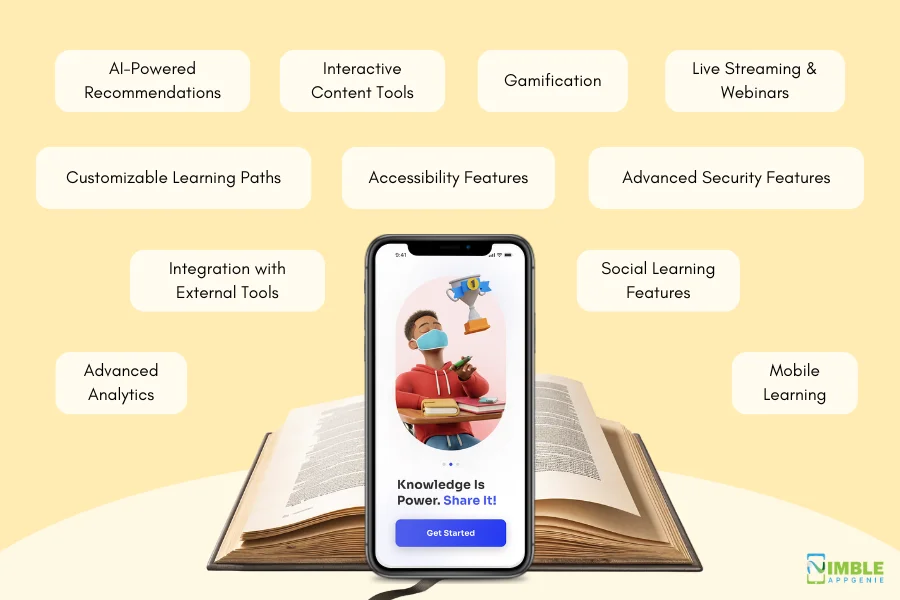
These are, as mentioned below:
AI-Powered Recommendations
Implement AI algorithms to provide personalized course recommendations for users based on their past behavior, preferences, and learning patterns. This ensures a tailored learning experience, increasing user engagement and satisfaction.
Interactive Content Tools
Incorporate tools that allow for the creation of interactive content such as quizzes, simulations, and even AR/VR experiences. This can make learning more engaging and improve retention rates by providing practical, hands-on learning experiences.
Gamification
Introduce elements of gamification such as badges, points, leaderboards, and rewards for course completion and participation. Gamification can significantly increase motivation and engagement among learners by tapping into their competitive nature.
Live Streaming and Webinars
Offer live streaming capabilities for lectures, webinars, and interactive sessions. This allows for real-time interaction between learners and instructors, fostering a more dynamic and engaging learning environment.
Advanced Analytics
Utilize advanced analytics to track and analyze user progress, engagement, and learning outcomes. This feature can provide valuable insights for learners, tutors, and administrators to improve learning strategies and platform offerings.
Integration with External Tools
Ensure seamless integration with popular third-party tools and services like Google Drive, Slack, Zoom, and others. This facilitates a more cohesive and flexible learning environment by allowing users to utilize various tools without leaving the platform.
Mobile Learning
Develop a companion mobile app or ensure mobile responsiveness to facilitate learning on the go. Features like offline access to course materials can make learning more accessible and convenient for users.
Over 67% of people now use mobile devices to access learning, highlighting the importance of mobile compatibility in e-learning platform development.
Social Learning Features
Implement social learning features such as discussion forums, group projects, and peer reviews. This encourages collaboration and communication among learners, enhancing the learning experience through community support.
Customizable Learning Paths
Allow learners to create customizable learning paths that align with their career goals or personal interests. This feature enables users to curate their learning journey, making it more relevant and goal-oriented.
Advanced Security Features
When you create your own learning platform, ensure the platform is equipped with advanced security features to protect user data and privacy. This includes encryption, secure authentication methods, and compliance with data protection regulations.
Accessibility Features
Incorporate accessibility features to ensure the platform is usable by individuals with disabilities. This includes screen reader compatibility, keyboard navigation, and adjustable text sizes, making the platform inclusive for all learners.
With all said and done, it’s finally time to learn how to build an online course website in the section below.
Steps to Build Your Own e-Learning Portal
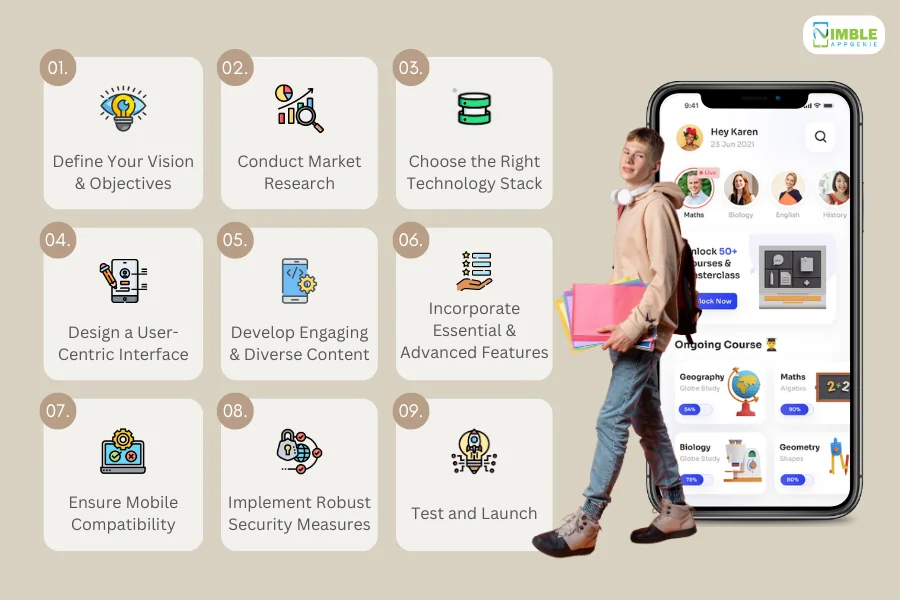
So, how do you create your own online course platform?
Creating an online learning portal isn’t rocket science, but it can be complicated for those who are new to the trade.
Regardless, here, we shall be discussing online learning platform development in detail.
Step 1: Define Your Vision and Objectives
We begin by defining the core purpose and objectives of your e-learning portal.
Here, you need to consider the specific needs you aim to address:
- target audience (such as professionals seeking skill development, students requiring academic support, or hobbyists looking to learn something new)
- and what will set your platform apart from existing offerings.
Establishing clear goals early on will guide your decision-making throughout the development process.
By opting for online courses, institutions can reduce their carbon footprint significantly. E-learning courses consume an average of 90% less energy and produce 85% fewer CO2 emissions per student than traditional face-to-face courses.
Step 2: Conduct Market Research
Thorough market research is crucial to understand your competition.
Identify gaps in the current market, and comprehend the needs and preferences of your target audience.
Analyze successful e-learning platforms to glean insights into features that engage users, content delivery methods that work well, and business models that sustain growth.
Surveys and focus groups can also provide direct feedback from potential users about their expectations.
Step 3: Choose the Right Technology Stack
The technology stack you choose will form the backbone of your e-learning portal. Factors to consider include scalability, security, user experience, and ease of maintenance.
| Category | Technology | Description |
| Front End | HTML, CSS, JavaScript | The core technologies for building the user interface, ensuring it’s user-friendly and responsive. |
| React.js / Angular / Vue.js | Popular JavaScript frameworks/libraries for building dynamic and interactive user interfaces. | |
| Back End | Node.js / Ruby on Rails / Django | Server-side frameworks that handle the logic, user authentication, and server configuration. |
| RESTful API / GraphQL | Technologies for building APIs that allow the front end and back end to communicate effectively. | |
| Database | MongoDB / PostgreSQL / MySQL | Database systems to store and manage user data, course content, progress tracking, etc. |
| Cloud Services | AWS / Google Cloud / Azure | Cloud platforms that provide scalable hosting, storage, and other services like content delivery networks (CDN). |
| Authentication | OAuth / JWT | Standard protocols for secure authentication and authorization of users. |
| Payment Gateway | Stripe / PayPal / Braintree | Services to process payments securely and efficiently. |
| E-learning Specific | SCORM / xAPI | Standards for e-learning content that allow interoperability between content and learning management systems. |
| Analytics | Google Analytics / Mixpanel | Tools for tracking user engagement, course completion rates, and other key performance indicators. |
| DevOps Tools | Docker / Kubernetes / Jenkins | Tools for containerization, orchestration, and continuous integration/continuous deployment (CI/CD), ensuring smooth deployment and scalability. |
| Security | SSL / TLS | Protocols for securing data transmission. Regular security audits and compliance checks are also essential. |
Step 4: Design a User-Centric Interface
The UI and UX design of your portal are critical to its success, when you create an online course platform.
A well-designed interface should be intuitive, engaging, and accessible, ensuring users of all skill levels can navigate and utilize the platform effectively.
Therefore, make sure to incorporate principles of good design.
Such as consistency, simplicity, and clear feedback mechanisms.
Pay special attention to the layout of courses, ease of content access, and interaction design for communication tools.
Step 5: Develop Engaging and Diverse Content
Content is king in the world of e-learning.
Your platform should offer a wide range of high-quality courses that cater to the varied interests and needs of your audience.
Therefore, consider partnering with experts, educators, and industry professionals to create engaging course materials that include videos, interactive quizzes, and real-world projects.
Regularly updating and expanding your course offerings will keep the platform dynamic and relevant.
Step 6: Incorporate Essential and Advanced Features
Start by integrating essential features such as user registration, course catalogs, payment gateways, and progress tracking.
Then, consider advanced features like AI-powered recommendations, gamification, live sessions, and interactive content to enhance the learning experience.
Remember to include robust admin features for content management, user support, and analytics.
Step 7: Ensure Mobile Compatibility
With the increasing use of mobile devices for learning, your e-learning portal must be mobile-friendly.
This could mean developing a responsive web design that adapts to different screen sizes or creating a dedicated mobile app.
Mobile compatibility improves accessibility and convenience, allowing users to learn on the go.
Also Read: How To Create An eLearning Mobile App?
Step 8: Implement Robust Security Measures
Protecting user data and ensuring the integrity of your platform is paramount.
Implement strong security measures, including data encryption, secure authentication protocols, and regular security audits.
Compliance with relevant data protection regulations, such as GDPR, is also essential to build trust with your users.
Step 9: Test and Launch
Before launching, conduct thorough testing to ensure the platform is user-friendly, content is accessible, and there are no technical glitches.
This includes usability testing, performance testing, and security testing. Gather feedback from beta testers and make necessary adjustments.
This is how you create an e-learning platform. However, it’s easier said than done. You can expect to face a lot of challenges. But where there is issue there’s an solution. Let’s discuss both of that below.
Common Challenges (& Solutions) of Creating Your Own eLearning Portal
There is not project without any challenges.
So, what are the challenges that you may expect when you build an online learning platform like Udemy? Well, in this section we shall be discussing exactly that as well as their solutions.
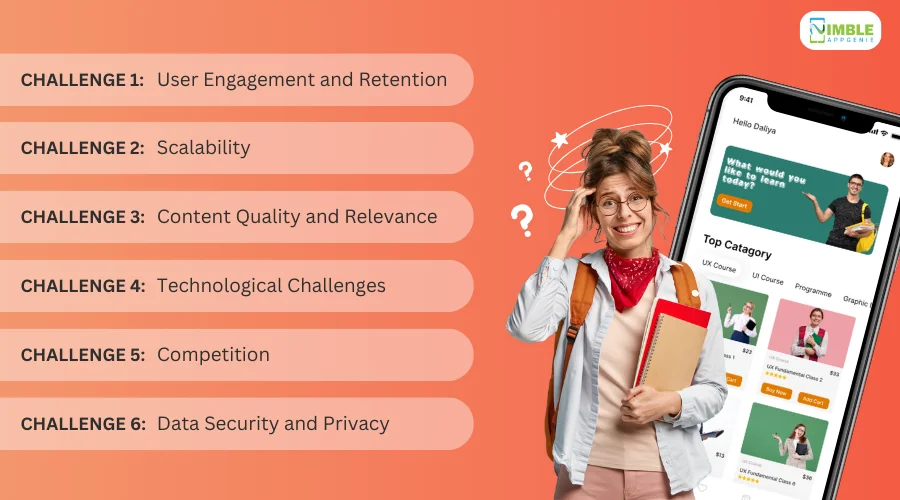
Let’s get right into it:
Challenge 1: User Engagement and Retention
One of the biggest challenges comes in form of driving user engagement and retention.
You see, you want users to use and stay on your app.
However, engaging users and keeping them committed to completing courses can be difficult, especially with the vast amount of free content available online.
E-learning has the potential to increase information retention rates by 25% to 60%, in stark contrast to traditional learning methods, which typically have retention rates of only 8-10%.
Solution: Enhance user engagement by incorporating interactive content, gamification elements, and personalized learning paths. Regularly update content and engage with users through forums, live sessions, and feedback channels to keep the platform dynamic and responsive to learner needs.
Challenge 2: Scalability
Want to grow and become successful among users?
Well, scalability can become a challenge.
As your platform grows, you might encounter issues with handling increased traffic and data, potentially leading to slow load times and a poor user experience.
Solution: Opt for scalable cloud services that allow you to adjust resources based on demand. Use efficient coding practices and consider a microservices architecture to ensure your platform can grow without performance issues.
Challenge 3: Content Quality and Relevance
Since we are talking about creating online education platform, it’s important to consider quality of content.
Now, maintaining high-quality, up-to-date content that meets the needs of a diverse audience is challenging.
Especially in fast-evolving fields.
Solution: Collaborate with industry experts and educators to create and regularly review content. Incorporate a variety of learning materials, including videos, quizzes, and interactive sessions, to cater to different learning styles.
Challenge 4: Technological Challenges
Tech stack plays an important role when you create an online learning portal.
Choosing the right technology stack and keeping up with technological advancements can be daunting, especially for those without a technical background.
Solution: Conduct thorough research or consult with technology experts to choose a stack that aligns with your needs. Consider hiring a skilled development team or partnering with a tech firm to leverage their expertise.
Challenge 5: Competition
If you know anything about online learning market, you know that it’s filled with top platforms.
This is to say, the e-learning market is highly competitive, with many platforms offering similar courses and features.
And this is one of the biggest challenges for new players.
Solution: Differentiate your platform by identifying and filling gaps in the market, focusing on niche areas, or providing unique learning experiences. Building a strong brand and community around your platform can also help set you apart.
Challenge 6: Data Security and Privacy
In the world of online education platforms that deal with huge data set of important info, security is must.
Protecting user data and ensuring privacy is paramount, especially with increasing concerns about data breaches and compliance with regulations like GDPR.
Solution: Implement robust security measures, including data encryption, secure authentication protocols, and regular security audits. Ensure compliance with relevant data protection laws by staying informed and consulting legal experts if necessary.
So, now that we are done with challenges and their solution, let’s see how much does it cost to develop such a platform.
Cost of Developing an Online Learning Platform
So, how much does it cost to develop an online learning portal like edX or code academy?
On average, cost of developing an online learning platform can range from $20,000 to $150,000 based on complexity, features, tech stack, deployment, and updates.
Web portal development cost often is unique to each project.
Therefore, if you are looking to get an accurate quote, consult experts.
5 Monetization Strategies to Get Great ROI
Now, after spending thousands to create an online learning platform, it’s time to make some back and by some we mean, A Lot.
Monetizing an online learning platform effectively is crucial for sustainability and growth.
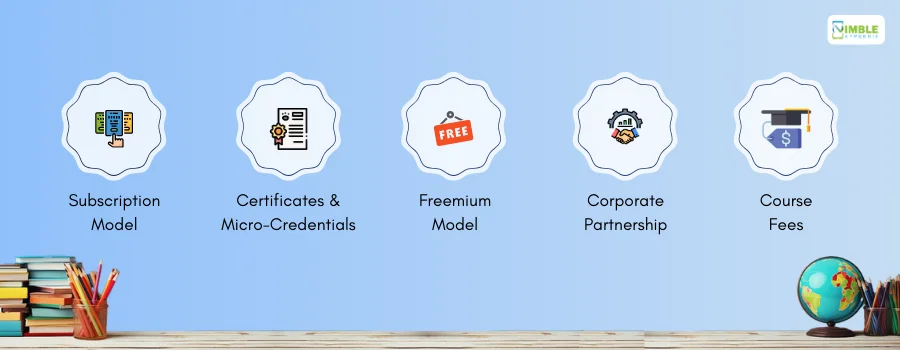
Here are five monetization strategies that can help you achieve a great return on investment (ROI) with your online learning portal:
1. Subscription Model
One of the most popular and steady revenue streams for e-learning platforms is the subscription model.
Users pay a recurring fee, typically monthly or annually, for access to the platform’s content and features.
This model encourages continuous engagement and provides predictable revenue. Offering different subscription tiers based on access levels or content can cater to a wider audience.
2. Course Fees
Charging users for individual courses or bundles allows for flexibility and can attract users who are interested in specific topics rather than a full subscription.
This pay-per-course model can be particularly effective for platforms offering specialized or high-value content, such as professional development courses, certifications, or courses created by renowned experts in the field.
3. Freemium Model
The freemium model offers basic content or features for free while charging for premium content or advanced features.
This approach can attract a large user base and convert a portion of those users to paying customers by offering compelling premium options.
It’s essential to strike the right balance between free and premium offerings to ensure users see the value in upgrading.
4. Corporate Partnerships
Partnering with businesses to offer their employees access to your platform can be a lucrative strategy.
Companies are often willing to invest in high-quality, relevant training for their employees.
Tailoring content to specific industries or job roles can make your platform more attractive to corporate clients.
Plus, offering analytics and reporting on employee progress and outcomes can add value to these partnerships.
5. Certifications and Micro-Credentials
Lastly, consider offering certifications or micro-credentials for course completion can be an additional revenue stream.
Many learners are willing to pay extra for a certificate that validates their learning and can be added to their professional portfolio.
Thus, ensuring that these certifications are recognized and valued by employers in relevant industries can enhance their appeal.
And this is how you can create online learning platform and make millions in revenue. But for that, you need a development partner. That’s where we come in.
Nimble AppGenie – Your Partner in Learning Portal Development
Want to create an online learning portal?
We can help!
Nimble AppGenie is a market leading education solution development company and we have what it takes to convert your idea into reality.
Over 700 projects and 95% client satisfaction later, we are recognized as one of the best by platforms like Clutch.co, DesignRush, TopDevelopers, GoodFirms, & many more.
Hire dedicated developers today and give your idea a digital life, with us.
Conclusion
The booming e-learning market offers a chance for businesses to create online learning platforms. Various platform types exist, from MOOCs to corporate training. Building one unlocks benefits like scalability and cost-effectiveness, but requires engaging content, a user-friendly design, and strong security. Consider challenges like user retention and competition. The cost to develop an e-learning platform can vary. Monetize your platform through subscriptions, course fees, or partnerships. So, are you ready to join the e-learning revolution?
FAQs
The cost of developing an e-learning platform can vary widely based on factors like platform complexity, chosen technology stack, and the number and sophistication of features. Costs can range from tens of thousands to hundreds of thousands of dollars for more complex platforms with advanced features.
The development time for an online learning platform can range from a few months to over a year, depending on the scope of the project, the complexity of features, and the development team’s size and efficiency. Planning, development, testing, and deployment phases all contribute to the timeline.
While it’s possible to use various platform-building tools that require minimal coding knowledge, creating a customized and scalable e-learning platform typically requires at least some level of programming expertise. Partnering with a development team or agency can be a solution for those without coding skills.
The “best” technology stack depends on your specific requirements, but a combination of modern front-end frameworks (like React or Angular), a robust back-end framework (such as Node.js or Django), a reliable database (like PostgreSQL or MongoDB), and cloud services (AWS, Google Cloud, or Azure) is commonly used.
Implementing strong security measures is crucial. This includes using secure authentication protocols (like OAuth), encryption for data transmission (SSL/TLS), regular security audits, and compliance with data protection regulations (like GDPR for European users).
Popular monetization strategies include subscription models, course fees, a freemium model, corporate partnerships, and offering certifications or micro-credentials. The choice of monetization strategy should align with your platform’s content and target audience.
With the increasing use of smartphones and tablets for learning, mobile compatibility is crucial. A mobile-responsive design or a dedicated mobile app can greatly enhance user accessibility and engagement.
Essential features include user registration and management, course catalogs, content management systems, payment gateways, progress tracking, and communication tools. Advanced features like AI-powered recommendations, gamification, and live streaming can further enhance the learning experience.
A solid marketing strategy involving SEO, content marketing, social media engagement, and targeted advertising can attract users. Offering high-quality, unique content and a seamless user experience are also key to retaining users.
This depends on your monetization strategy. Some platforms offer free courses to attract a large user base and then monetize through premium features or content, while others charge for course access from the start. Offering a mix of free and paid content can cater to a wider audience.

Yashshree Purohit, an experienced Technical Content Writer at Nimble AppGenie boasts over 5 years of expertise crafting compelling content across multiple domains. Passionate about transforming complex ideas into clear and compelling narratives, she excels in creating content that resonates with the audience.
Table of Contents




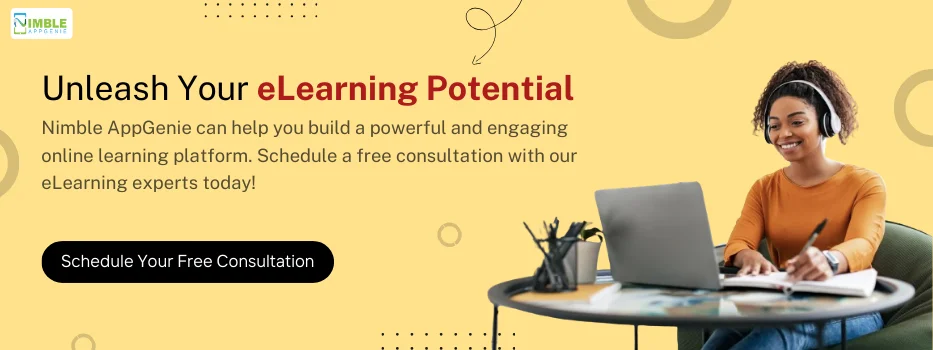
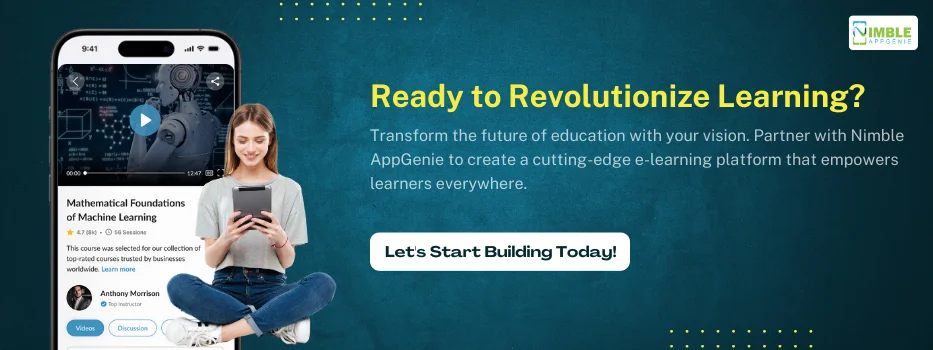
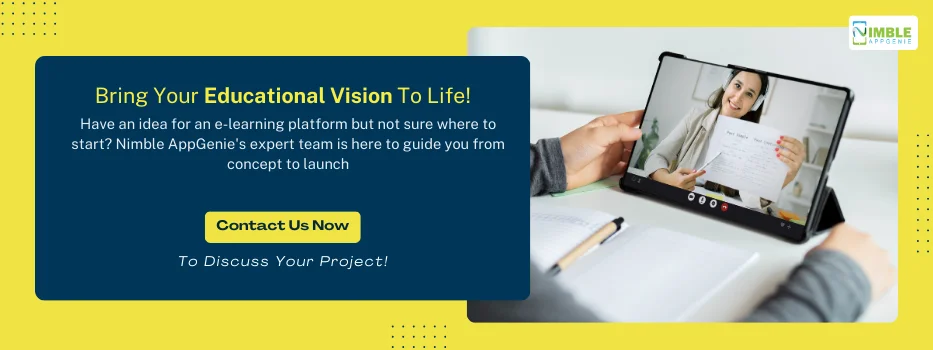









No Comments